Charles E W Bean, Diaries, AWM38 3DRL 606/260/1 - 1916 - 1930 - Part 6
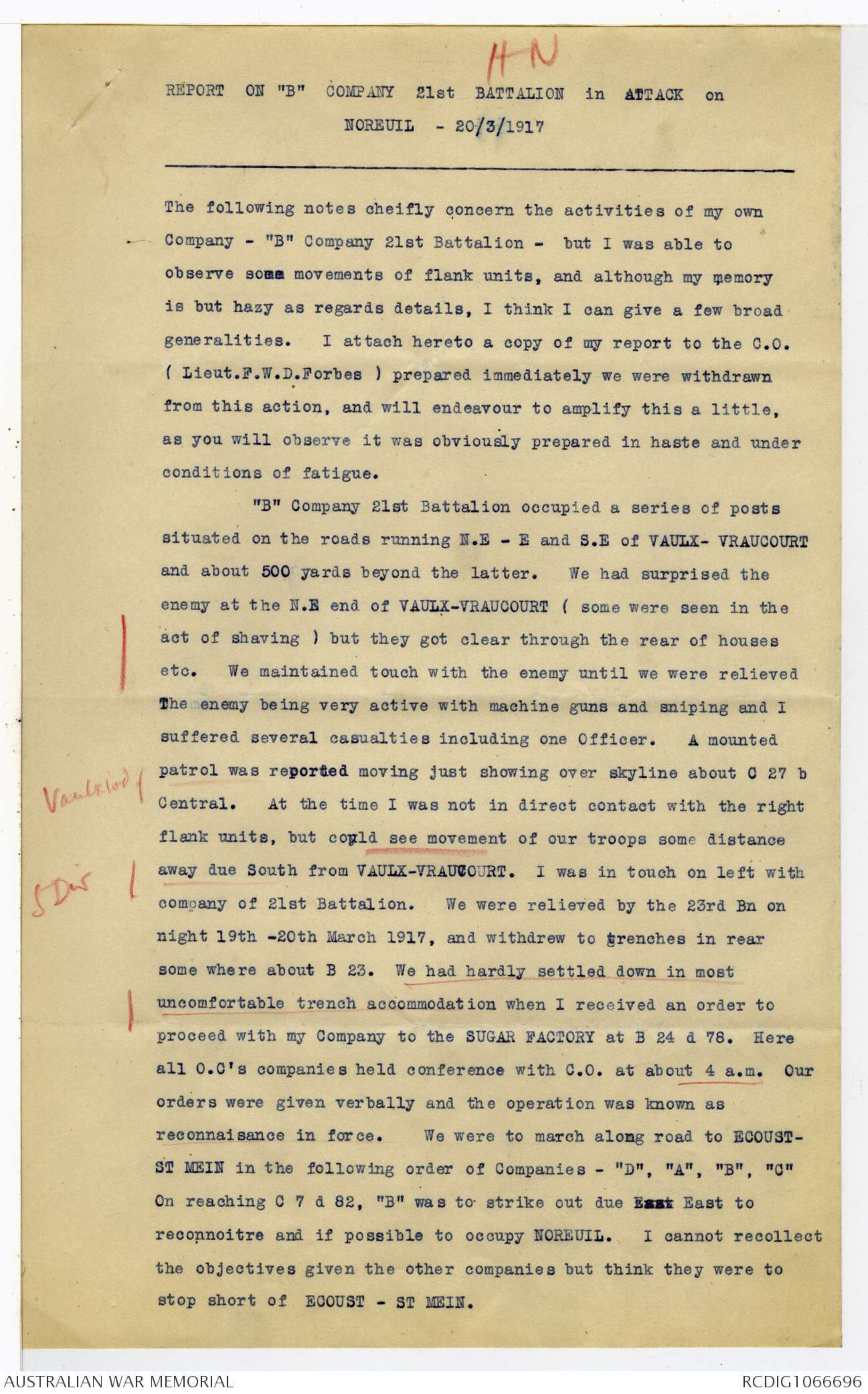
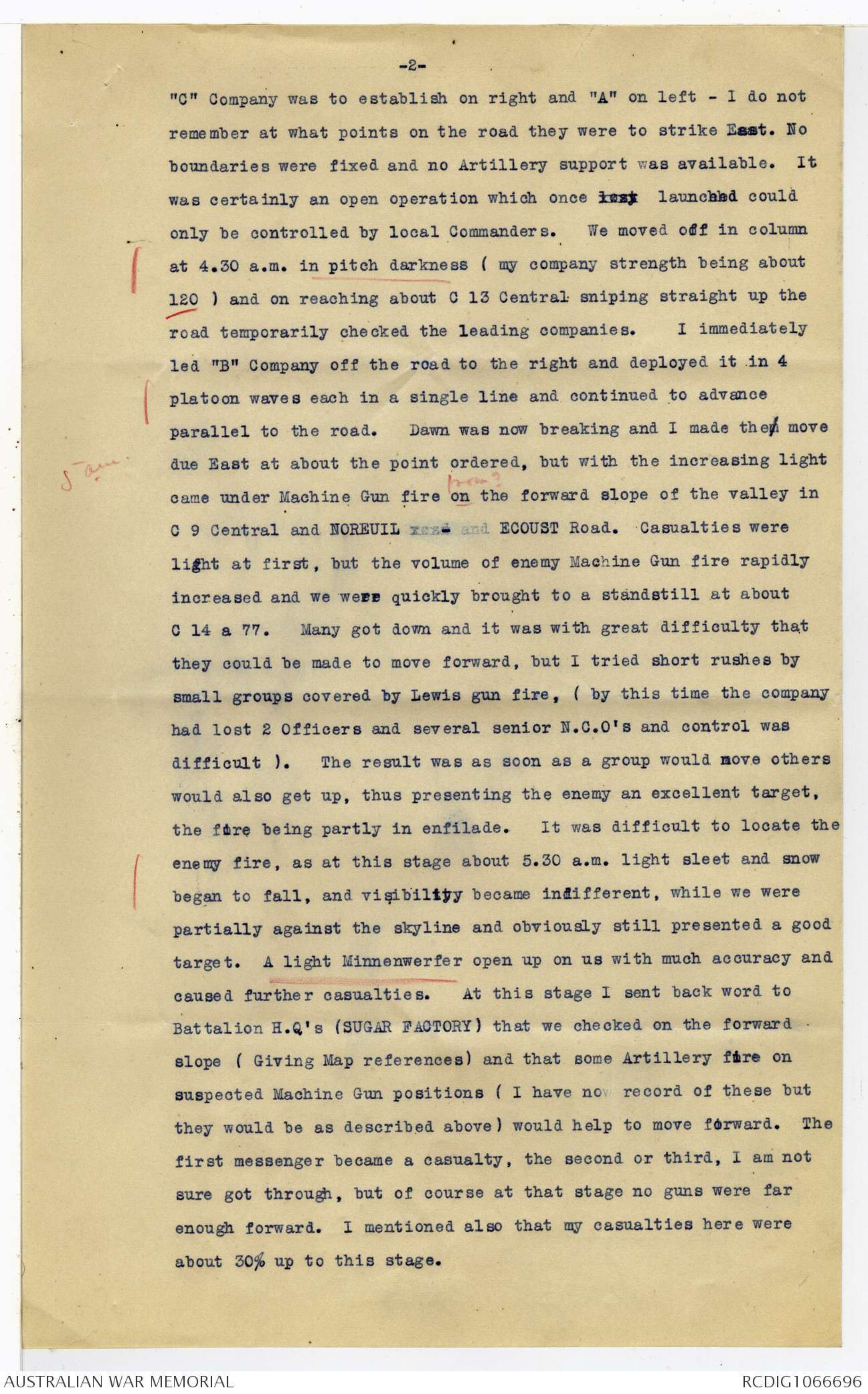
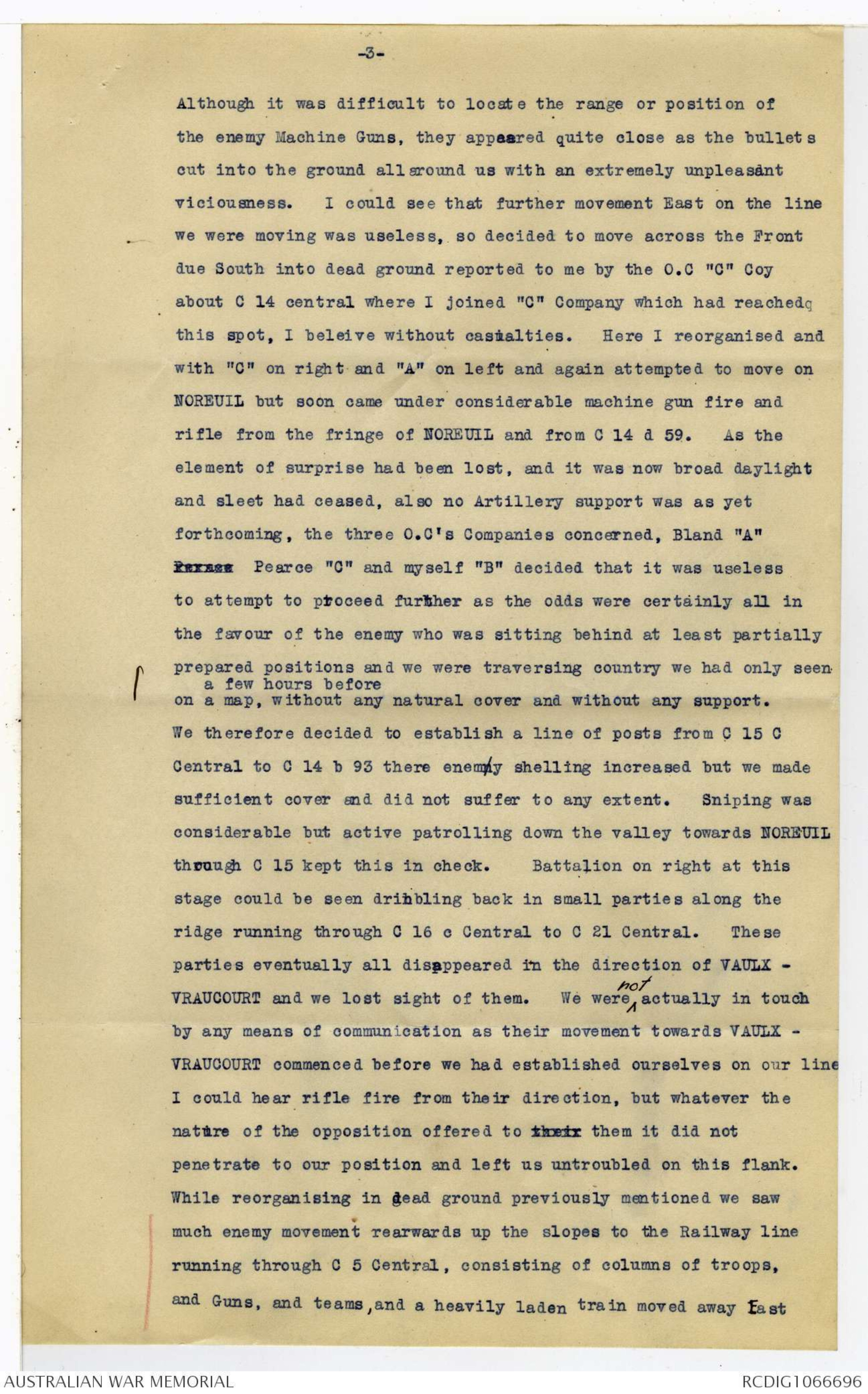
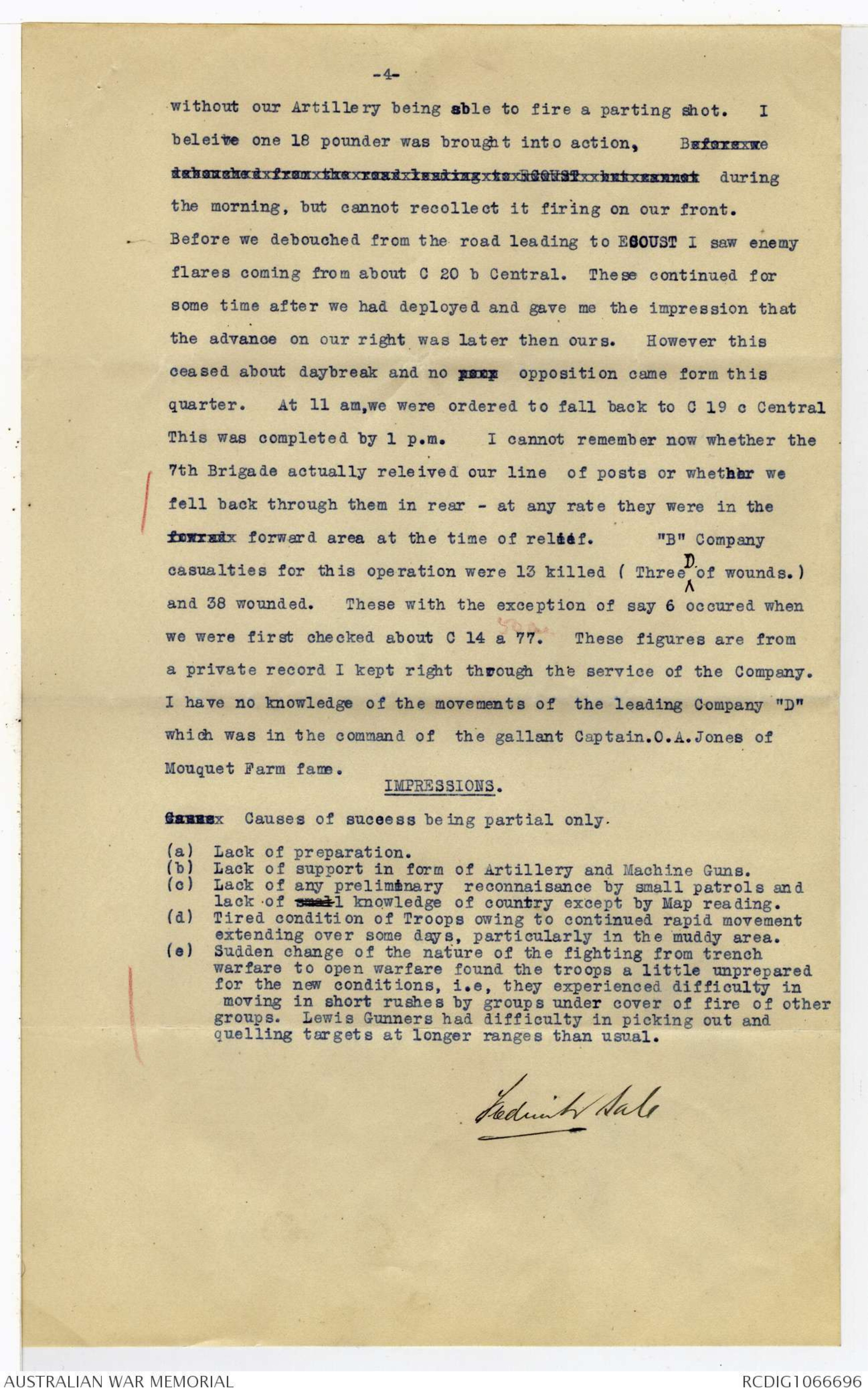
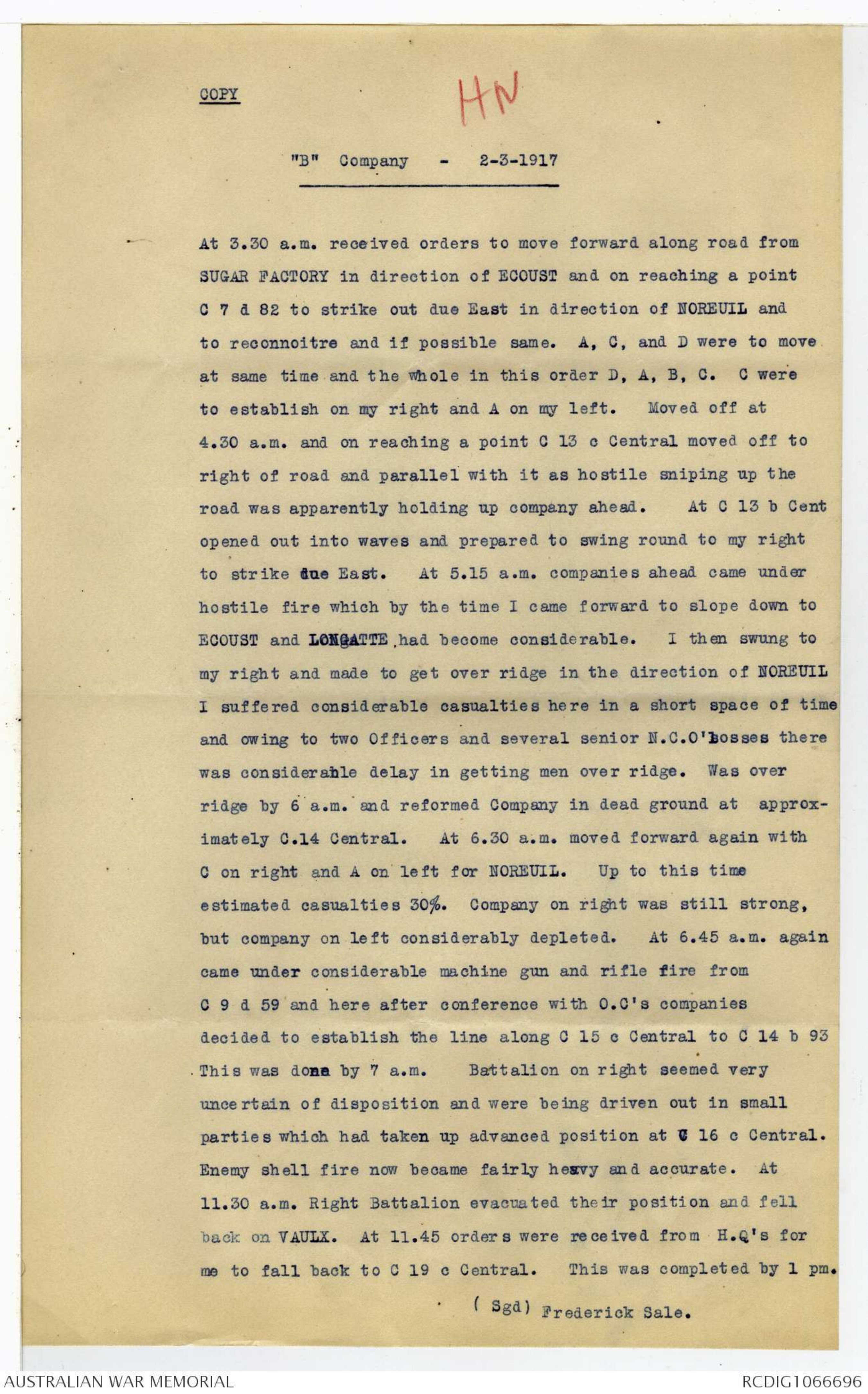
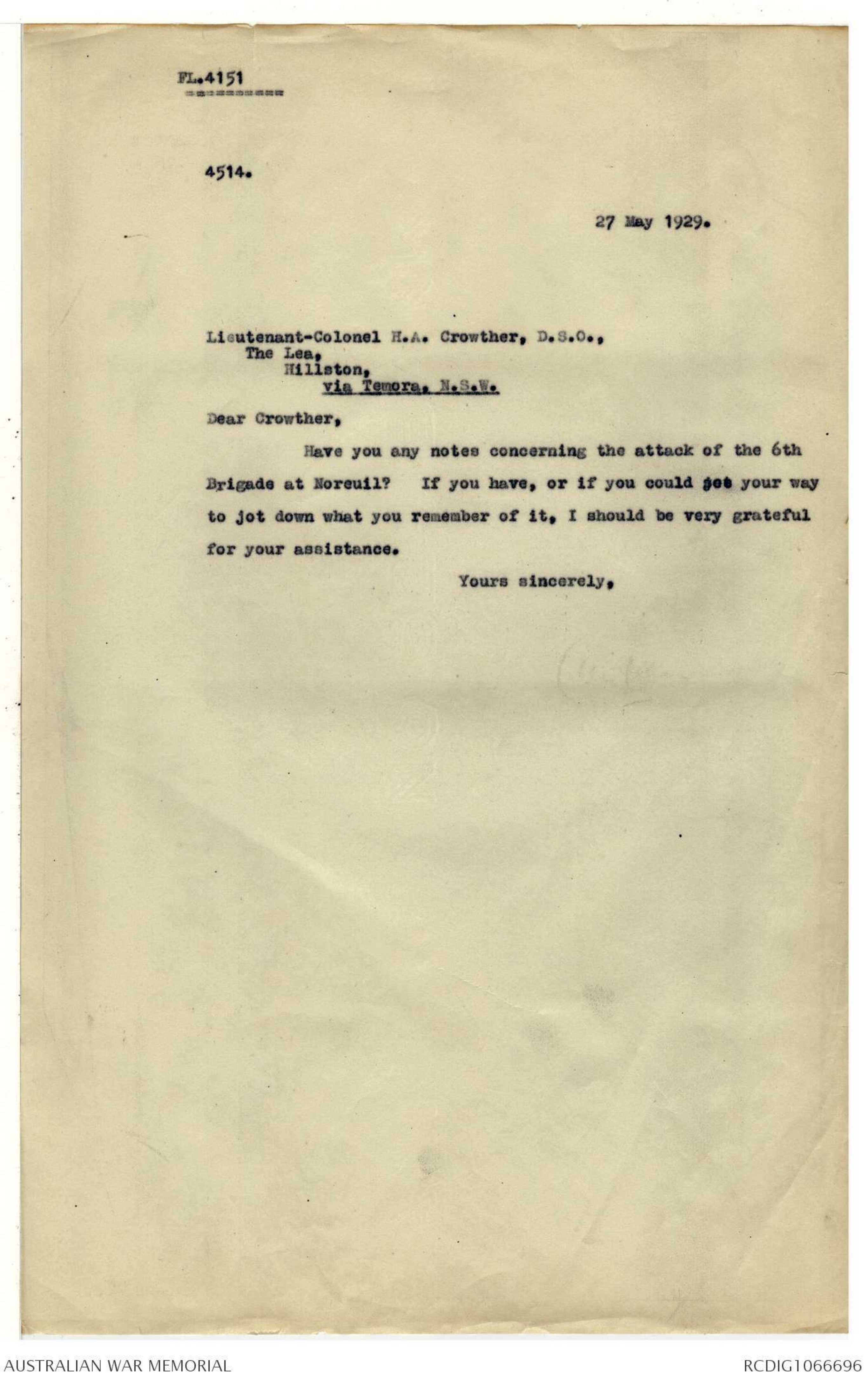
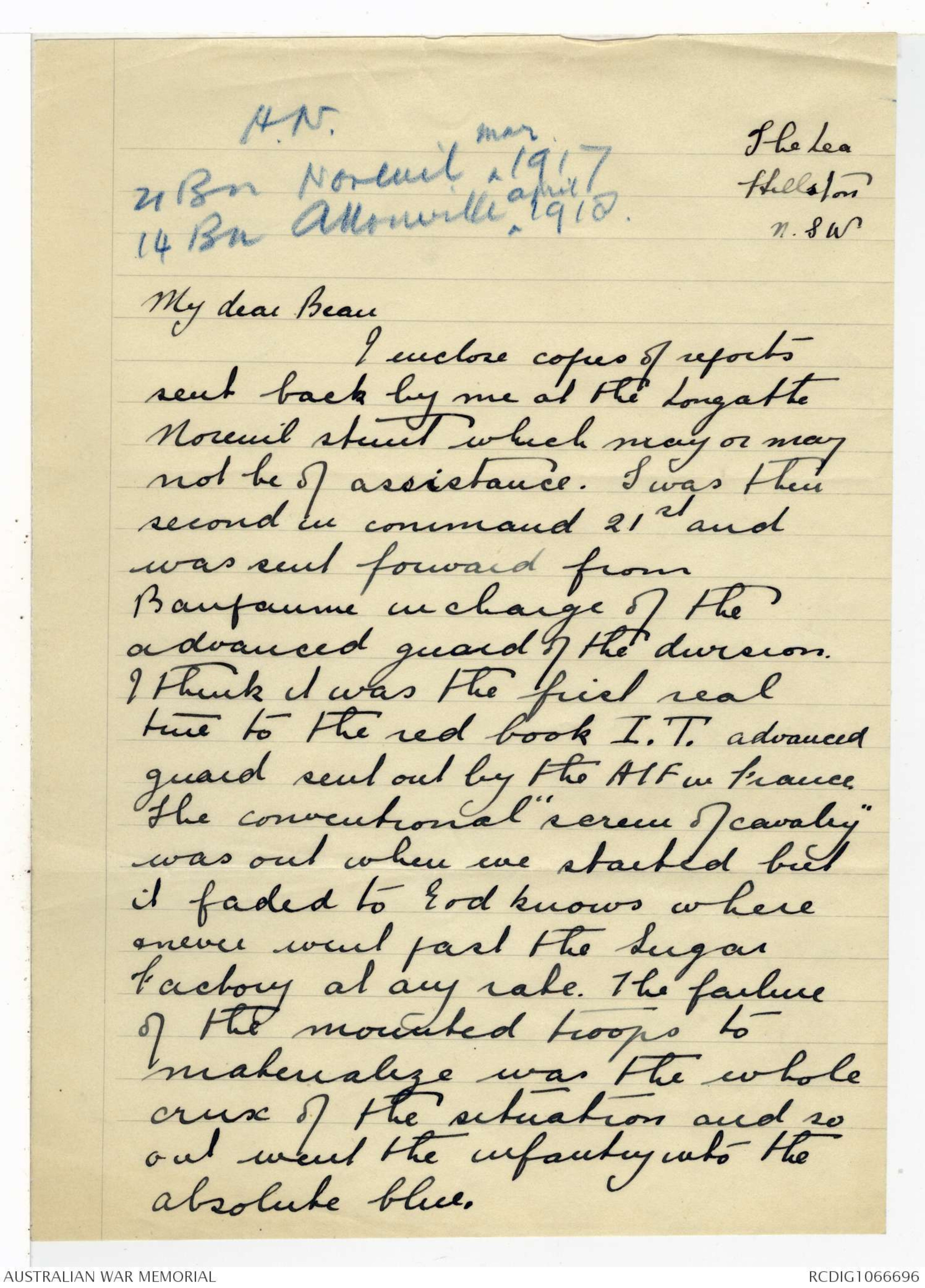

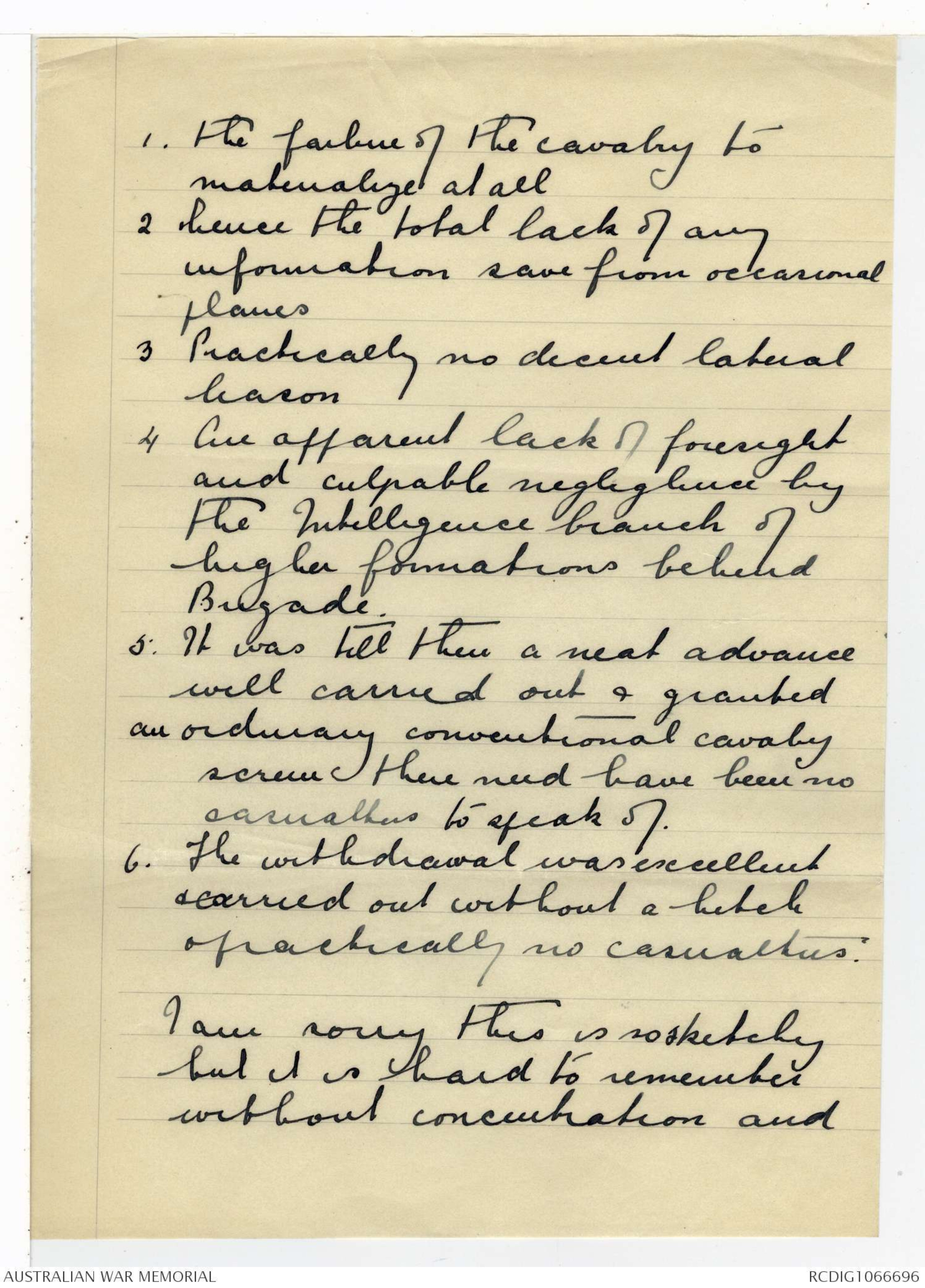
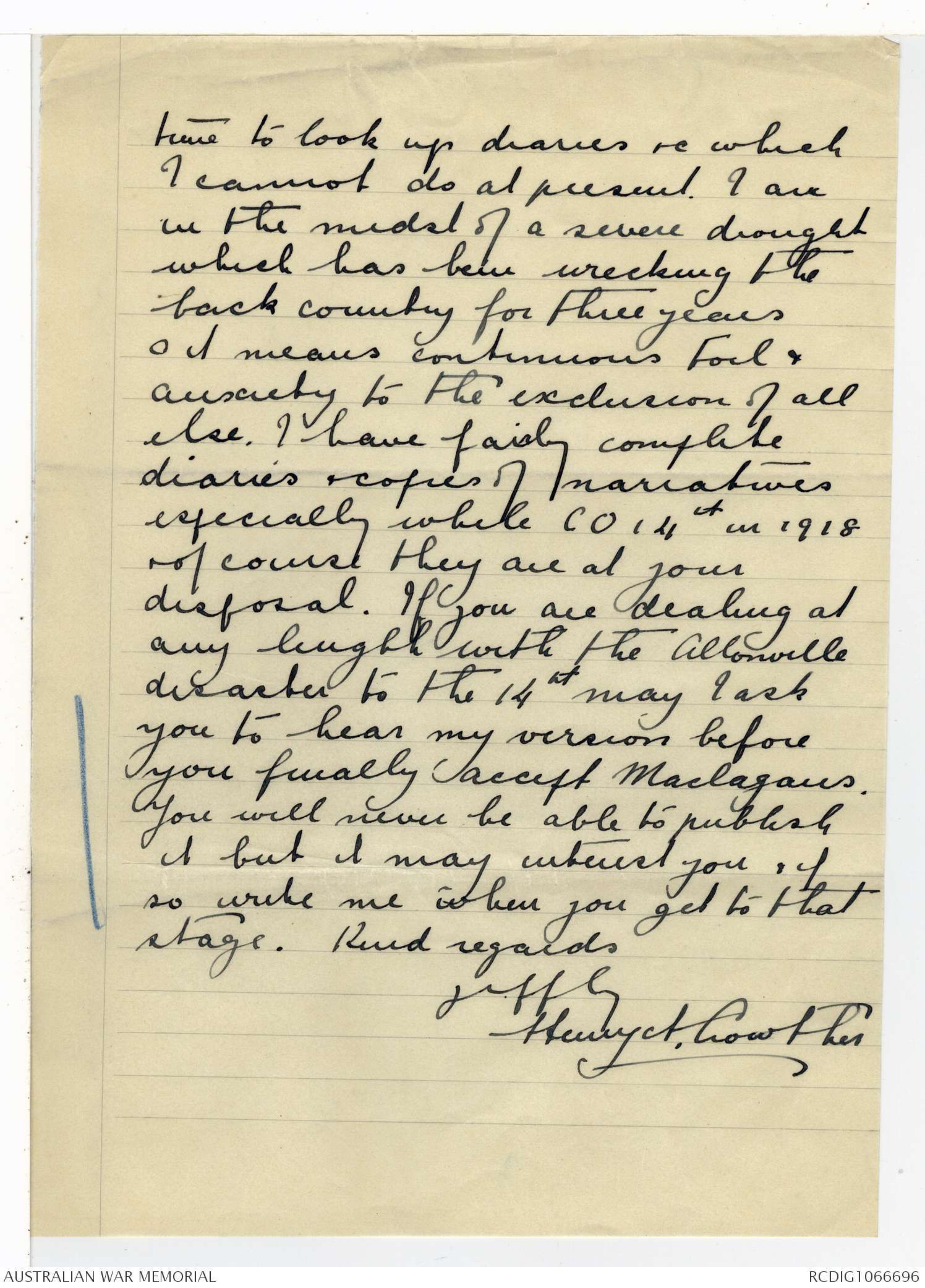
HN
REPORT ON "B" COMPANY 21st BATTALION in ATTACK on
NOREUIL - 20/3/1917
------------------------------------------------------
The following notes cheifly concern the activities of my own
Company - "B" company 21st Battalion - but I was able to
observe some movements of flank units, and although my memory
is but hazy as regards details, I think I can give a few broad
generalities. I attach hereto a copy of my report to the C.O.
(Lieut F.W.D.Forbes) prepared immediately we were withdrawn
from this action, and will endeavour to amplify this a little,
as you will observe it was obviously prepared in haste and under
conditions of fatigue.
"B" Company 21st Battalion occupied a series of posts
situated on the roads running N.E. - E and S.E of VAULX - VRAUCOURT
and about 500 yards beyond the latter. We had surprised the
enemy at the N.E end of VAULX-VRAUCOURT (some were seen in the
act of shaving) but they got clear through the rear of houses
etc. We maintained touch with the enemy until we were relieved
The enemy being very active with machine guns and sniping and I
suffered several casualties including one Officer. A mounted
[*Vaulxwd*]
patrol was reported moving just showing over skyline about C 27 b
Central. At the time I was not in direct contact with the right
flank units, but could see movement of our troops some distance
[*5 Div*]
away due South from VAULX-VRAUCOURT. I was in touch on left with
company of 21st Battalion. We were relieved by the 23rd Bn on
night 19th - 20th March 1917, and withdrew to trenches in rear
some where about B 23. We hardly settled down in most
uncomfortable trench accommodation when I received an order to
proceed with my Company to the SUGAR FACTORY at B 24 d 78. Here
all O.C's companies held conference with C.O. at about 4 a.m. Our
orders were given verbally and the operation was known as
reconnaisance in force. We were to march along road to ECOUST-
ST MEIN in the following order of Companies - "D", "A", "B", "C"
On reaching C d 82, "B" was to strike out due East East to
reconnoitre and if possible to occupy NOREUIL. I cannot recollect
the objectives given the other companies but think they were to
stop short of ECOUST-ST MEIN.
-2-
"C" Company was to establish on right and "A" on left - I do not
remember at what points on the road they were to strike East. No
boundaries were fixed and no Artillery support was available. It
was certainly an open operation which once lost launched could
only be controlled by local Commanders. We moved off in column
at 4.30 a.m in pitch darkness (my company strength being about
120) and on reaching about C 13 Central sniping straight up the
road temporarily checked the leading companies. I immediately
led "B" Company off the road to the right and deployed it in 4
platoon waves each in a single line and continued to advance
parallel to the road. Dawn was now breaking and I made them move
[*5 a.m.*]
due East at about the point ordered, but with the increasing light
came under Machine Gun fire on from? the forward slope of the valley in
C 9 Central and NOREUIL xxx and ECOUST Road. Casualties were
light at first, but the volume of enemy Machine Gun fire rapidly
increased and we were quickly brought to a standstill at about
C 14 a 77. Many got down and it was with great difficulty that
they could be made to move forward, but I tried short rushes by
small groups covered by Lewis gun fire, (by this time the company
had lost 2 Officers and several senior N.C.Os and control was
difficult). The result was as soon as a group would move others
would also get up, thus presenting the enemy an excellent target,
the fire being partly in enfilade. It was difficult to locate the
enemy fire, as at this stage about 5.30 a.m. light sleet and snow
began to fall, and visibility became indifferent, while we were
partially against the skyline and obviously still presented a good
target. A light Minnenwerfer open up on us with much accuracy and
caused further casualties. At this stage I sent back word to
Battalion H.Q's (SUGAR FACTORY) that we checked on the forward
slope (Giving Map references) and that some Artillery fire on
suspected Machine Gun positions (I have no record of these but
they would be as described above) would help to move forward. The
first messenger became a casualty, the second or third, I am not
sure got through, but of course at that stage no guns were far
enough forward. I mentioned also that my casualties here were
about 30% up to this stage.
-3-
Although it was difficult to locate the range or position of
the enemy Machine Guns, they appeared quite close as the bullets
cut into the ground all around us with an extremely unpleasant
viciousness. I could see that further movement East on the line
we were moving was useless, so decided to move across the Front
due South into dead ground reported to me by the O.C "C" Coy
about C 14 central where I joined "C" Company which had reached
this spot, I believe without casualties. Here I reorganised and
with "C" on right and "A" on left and again attempted to move on
NOREUIL but soon came under considerable machine gun fire and
rifle from the fringe of NOREUIL and from C 14 d 59. As the
element of surprise had been lost, and it was now broad daylight
and sleet had ceased, also no Artillery support was as yet
forthcoming, the three O.C's Companies concerned, Bland "A"Pxxxce Pearce "C" and myself "B" decided that it was useless
to attempt to proceed further as the odds were certainly all in
the favour of the enemy who was sitting behind at least partially
prepared positions and we were traversing country we had only seen
a few hours before
on a map, without any natural cover and without any support.
We therefore decided to establish a line of posts from C 15 C
Central to C 14 b 93 there enemny shelling increased but we made
sufficient cover and did not suffer to any extent. Sniping was
considerable but active patrolling down the valley towards NOREUIL
through C 15 kept this in check. Battalion on right at this
stage could be seen dribbling back in small parties along the
ridge running through C 16 c Central to C 21 Central. These
parties eventually all disappeared in the direction of VAULX -
VRAUCOURT and we lost sight of them. We were ^not actually in touch
by any means of communication as their movement towards VAULX -
VRAUCOURT commenced before we had established ourselves on our line
I could hear rifle fire from their direction, but whatever the
nature of the opposition offered to their them it did not
penetrate to our position and left us untroubled on this flank.
While reorganising in dead ground previously mentioned we saw
much enemy movement rearwards up the slopes to the Railway line
running through C 5 Central, consisting of columns of troops,
and Guns, and teams, and a heavily laden train moved away East
-4-
without our Artillery being able to fire a parting shot. I
beleive one 18 pounder was brought into action, Before wedebouched from the road landing to ECOUST but cannot during
the morning, but cannot recollect it firing on our front.
Before we debouched from the road leading to ECOUST I saw enemy
flares coming from about C 20 b Central. These continued for
some time after we had deployed and gave me the impression that
the advance on our right was later then ours. However this
ceased about daybreak and no poop opposition came form this
quarter. At 11 am, we were ordered to fall back to C 19 c Central
This was completed by 1 p.m. I cannot remember now whether the
7th Brigade actually releived our line of posts or whether we
fell back through them in rear - at any rate they were in thefowradx forward area at the time of relief. "B" Company
casualties for this operation were 13 killed (Three ^D. of wounds.)
and 38 wounded. These with the exception of say 6 occured when
we were first checked about C 14 a 77.[*500*] These figures are from
a private record I kept right through the service of the Company.
I have no knowledge of the movements of the leading Company "D"
which was in the command of the gallant Captain.O.A.Jones of
Mouquet Farm fame.
IMPRESSIONS.Casesx Causes of success being partial only.
(a) Lack of preparation.
(b) Lack of support in form of Artillery and Machine Guns.
(c) Lack of any preliminary reconnaisance by small patrols and
lack of small knowledge of country except by Map reading.
(d) Tired condition of Troops owing to continued rapid movement
extending over some days, particularly in the muddy area.
(e) Sudden change of the nature of the fighting from trench
warfare to open warfare found the troops a little unprepared
for the new conditions, i.e, they experienced difficulty in
moving in short rushes by groups under cover of fire of other
groups. Lewis Gunners had difficulty in picking out and
quelling targets at longer ranges than usual.
Frederick Sale
COPY HN
"B" Company - 2-3-1917
------------------------------------
At 3.30 a.m. received orders to move forward along road from
SUGAR FACTORY in direction of ECOUST and on reaching a point
C 7 d 82 to strike out due East in direction of NOREUIL and
to reconnoitre and if possible same. A, C, and D were to move
at same time and the whole in this order D, A, B, C. C were
to establish on my right and A on my left. Moved off at
4.30 a.m. and on reaching a point C 13 c Central moved off to
right of road and parallel with it as hostile sniping up the
road was apparently holding up company ahead. At C 13 b Cent
opened out into waves and prepared to swing round to my right
to strike due East. At 5.15 a.m. companies ahead came under
hostile fire which by the time I came forward to slope down to
ECOUST and LONGATTE had become considerable. I then swung to
my right and made to get over ridge in the direction of NOREUIL
I suffered considerable casualties here in a short space of time
and owing to two Officers and several senior N.C.O' losses there
was considerable delay in getting men over ridge. Was over
ridge by 6 a.m. and reformed Company in dead ground at approximately
C.14 Central. At 6.30 a.m. moved forward again with
C on right and A on left for NOREUIL. Up to this time
estimated casualties 30%. Company on right was still strong,
but company on left considerably depleted. At 6.45 a.m. again
came under considerable machine gun and rifle fire from
C 9 d 59 and here after conference with O.C's companies
decided to establish the line along C 15 c Central to C 14 b 93
This was done by 7 a.m. Battalion on right seemed very
uncertain of disposition and were being driven out in small
parties which had taken up advanced position at C 16 c Central.
Enemy shell fire now became fairly heavy and accurate. At
11.30 a.m. Right Battalion evacuated their position and fell
back on VAULX. At 11.45 orders were received from H.Q's for
me to fall back to C 19 c Central. This was completed by 1 p.m.
(Sgd) Frederick Sale.
FL. 4151
======
4514.
27 May 1929.
Lieutenant-Colonel H.A. Crowther, D.S.C.,
The Lea,
Hillston,
via Temora. N.S.W.
Dear Crowther,
Have you any notes concerning the attack of the 6th
Brigade at Noreuil? If you have, or if you could see your way
to jot down what you remember of it, I should be very grateful
for your assistance.
Yours sincerely,
CEW Bean
H.N.
21 Bn Noreuil ^Mar. 1917
14 Bn Allonville ^April 1918.
The Lea
Hillston
N.S W
My dear Bean
I enclose copies of reports
sent back by me at the Longatte
Noreuil stunt which may or may
not be of assistance. I was then
second in command 21st and
was sent forward from
Baupaume in charge of the
advanced guard of the division.
I think it was the first real
time to the red book I.T. advanced
guard sent out by the AIF in France
The conventional "screen of cavalry"
was out when we started but
it faded to God knows where
& never went past the Sugar
Factory at any rate. The failure
of the mounted troops to
materialize was the whole
crux of the situation and so
out went the infantry into the
absolute blue.
Fritz let the scout screen get well
clear over the ridge and waited
for the vanguard which was
supposed to be in artillery formations.
However I got the wind up and
extended them below the crest
which was heaven-sent foresight.
As soon as the line topped the
ridge he sniped the scouts &
put up a heavy M G fire along
the crest while several pip squeak
[[?babbens]] opened with shrapnel
over open sights. A fly couldn't
have lived on the sky line.
The 23rd on our right failed
to get forward and a
Tommy bn on our left never
got into the hunt. From memory
it was a unit of the ill-famed
64th division. We hung on to the
crest & later Gen Gellibrand
ordered a withdrawal & a
consolidation behind the
crest. The salient points are
1. The failure of the cavalry to
materialize at all
2 hence the total lack of any
information save from occasional
planes
3 Practically no decent lateral
liason
4 An apparent lack of foresight
and culpable negligence by
the Intelligence branch of
higher formations behind
Brigade.
5. It was till then a neat advance
well carried out & granted
an ordinary conventional cavalry
screen there need have been no
casualties to speak of.
6. The withdrawal was excellent
& carried out without a hitch
& practically no casualties.
I am sorry this is so sketchy
but it is hard to remember
without concentration and
time to look up diaries &c which
I cannot do at present. I am
in the midst of a severe drought
which has been wrecking the
back country for three years
& it means continuous toil &
anxiety to the exclusion of all
else. I have fairly complete
diaries & copies of narratives
especially while CO 14th in 1918
& of course they are at your
disposal. If you are dealing at
any length with the Allonville
disaster to the 14th may I ask
you to hear my version before,
you finally accept Maclagans.
You will never be able to publish
it but it may interest you & if
so write me when you get to that
stage. Kind regards
yr ffly
Henry A. Crowther.
 Sandy Mudie
Sandy MudieThis transcription item is now locked to you for editing. To release the lock either Save your changes or Cancel.
This lock will be automatically released after 60 minutes of inactivity.